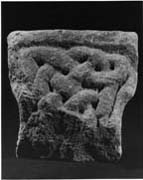Select a site alphabetically from the choices shown in the box below. Alternatively, browse sculptural examples using the Forward/Back buttons.
Chapters for this volume, along with copies of original in-text images, are available here.
Object type: Cross-arm [1]
Measurements: H. 30 cm (11.8 in); W. 26.5 cm (10.2 in); D. 15 cm (5.9 in)
Stone type: Coarse-grained, massive yellow sandstone
Plate numbers in printed volume: Pl. 25.134-138
Corpus volume reference: Vol 1 p. 57-58
(There may be more views or larger images available for this item. Click on the thumbnail image to view.)
Head, type A9.
A (broad): The head is edged with a flat-band moulding to which a six-cord plait is attached. The strands are quite well modelled but unevenly spaced. This may be because of the difficulty of turning a six-cord into a four-cord plait.
B and D (narrow): The sides are plain, but the smoother dressing near the end of the arms and the rough protuberances in the centre possibly suggest that there may have been a ring on the head.
C (broad): So worn that the pattern is almost obliterated. However, it is clear that the interlace pattern is edged by a flat-band moulding. The interlace seems to be a well spaced six-cord plait with median-incised strands, possibly turning into a four-cord plait at the centre of the cross.
The use of incised, and plain but well-modelled, interlace on the same shaft is found on 1 and 7. It is impossible to say whether this cross-head fits one or the other shaft, but it seems nearer in technique to 1. The arm type is the commonest in the free-armed form in co. Durham in the tenth to eleventh century, but it is just possible, in view of the Anglo-Viking ornament on shaft 1, that it could have been a ring-head.



